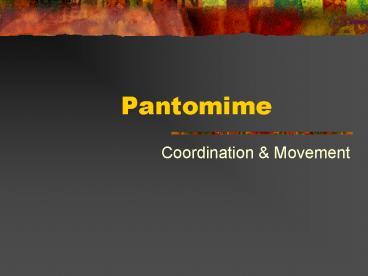Pantomime - PowerPoint PPT Presentation
1 / 17
Title:
Pantomime
Description:
A French actor (born in Strasburg, France in 1923) made Americans aware of the ... cross country tours of full evening programs on stage and television appearances. ... – PowerPoint PPT presentation
Number of Views:3213
Avg rating:3.0/5.0
Title: Pantomime
1
Pantomime
- Coordination Movement
2
What is Pantomime?
- the art of acting without words
- Sometimes called the art of silence
Why is pantomime important?
All actors are seen before they are heard.
3
- Pantomime is a silent form of drama in which the
story is developed by
- Movement
- Facial Expression
- Stage Properties
- Gestures
4
Roman Pantomime
- Pantomime was introduced in Rome in 22 BC
a single actor/dancer (pantomimus) mimed a
story, playing all the parts himself
supported by a chorus of singers and /or a small
orchestra
Pantomimus w/ mask and tunic
5
Pantomime in Italy
- Traditional characters of pantomime originated
in the Italian commedia dellarte of the 16th
century.
Consisted of a troupe of 10 people 7 male 3
female
Commedia dellarte is Italian for play of
professional artists
6
Japanese Pantomime Kabuki
- Female Kabuki began in 1603 when Izumo no Okuni,
a young woman in the service of a Shinto shrine,
began performing a new style of dance drama in
dry river beds of Kyoto.
Female performers played both the male and
female roles in comic plays about ordinary life.
Men took over the art form in 1653.
7
Pantomime in Europe
Joseph Grimaldi and Jean Gaspard Deburau were
famous pantomime stars of the 19th century.
Grimaldi from England
Deburau was a Bohemian-French pantomime.
8
A French Actor Popularized Pantomime
A French actor (born in Strasburg, France in
1923) made Americans aware of the power of mime
through
mimodramas-- cross country tours of full
evening programs on stage and television
appearances.
Marcel Marceau
Marcel Marceau is universally acclaimed as the
worlds greatest mime.
9
Other Silent Screen Actors Marceau Admired
Action is more generally understood than words.
Lifting an eyebrow, however faint, may convey
more than a hundred words. Interview NY Times
25/01/1931
Silent films permit audiences to place their own
interpretations on every act and gesture, and it
is the test of the actor to put over his meaning
with these. British United Press Interview May
3, 1929
Charlie Chaplin, born April 16, 1889
10
Other Silent Screen Actors Marceau Admired
Their act was about how to discipline a prankster
child. Buster was thrown all over the stage and
into the audience.
When at six months he tumbled down a flight of
stairs he was given the name Buster by Harry
Houdini who shared an act in vaudeville with
Buster and his parents.
No matter what the stunt, he kept a poker face.
(Performed during 1920s.)
Joseph Francis Buster Keaton, born Oct. 4, 1895
11
Other Silent Screen Actors Marceau Admired
Oliver Hardy (Jan. 18, 1892)
Laurel and Hardys partnership at the Hal Roach
studio began in 1926.
They collaborated on many silent films and later
transitioned to talking films.
Stan Laurel (June 16, 1890)
They won an Oscar for their short subject
entitled The Music Box (1932).
12
The Purpose of Pantomime
To encourage 1. meaningful movement, 2.
significant gestures, 3. animated facial
expressions
An actors personal appearance is important to
character portrayal.
Pantomime focuses on posture, movement, and
gestures.
13
Physical Training for Pantomime
Any exercise that develops physical coordination
is valuable in developing the coordination needed
for pantomime.
Fencing and dancing
Tennis, golf, swimming
Aerobic exercise and yoga
14
Relaxation Exercises
Relaxation inner composure, mental awareness,
and physical flexibility .
Successful actors, like athletes, must not be
tense, emotionally or physically .
15
Relaxation Head to Toe
1. Raise, lower, and rotate your head w/out
moving your shoulders
2. Rotate shoulders forward and backward
3. Move your arms in wide circles, first close
to the body and then shoulder height.
4. Rotate your lower arms from the elbow,
clockwise and then counter clockwise. Hold your
arms straight down and slightly away from your
body.
5. Rotate your hands from the wrists.
6. Lift your arms with wrists leading, first to
the side then to the front
16
Relaxation Head to Toe
7. Shake your hands vigorously, keeping them
completely relaxed.
8. Open and close your fists, stretching the
fingers apart and then drawing them together.
9. Bend your body forward, back, and to each
side.
10. Clasping your hands together, push your arms
vigorously above your head. Then rotate your
body to the left and to the right, keeping your
head within your arms.
11. Rotate each leg in circles, kick as high as
possible, and swing each leg forward and back.
17
Relaxation Head to Toe
12. Rise on your toes, bend your knees, and sit
on your heels.
13. Rotate each foot at the ankle.
Additional Relaxation Technique
Beginning at the top of your head
1. Breath in and then tense a section of your body
2. Breath out as you release the tension
3. Continue until you reach youre the bottom of
your feet















![[PDF] DOWNLOAD Dickens's Clowns: Charles Dickens, Joseph Grimaldi and PowerPoint PPT Presentation](https://s3.amazonaws.com/images.powershow.com/10064411.th0.jpg?_=20240626046)


![⚡[PDF]✔ It's a Drag: Cross-Dressing in Performance PowerPoint PPT Presentation](https://s3.amazonaws.com/images.powershow.com/10053405.th0.jpg?_=202406111110)
![[PDF]❤️DOWNLOAD⚡️ It's a Drag: Cross-Dressing in Performance PowerPoint PPT Presentation](https://s3.amazonaws.com/images.powershow.com/10045817.th0.jpg?_=202406031212)

![[PDF]❤️DOWNLOAD⚡️ It's a Drag: Cross-Dressing in Performance PowerPoint PPT Presentation](https://s3.amazonaws.com/images.powershow.com/10046829.th0.jpg?_=20240604125)









